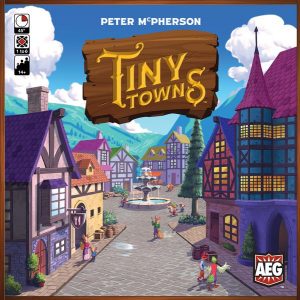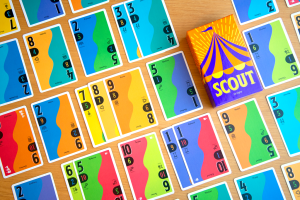
Ganz Schon Clever/Doppel So Clever
1-4 players
10-30 mins
Complexity – 2/3 out 5

THIS GAME! Almost every all our staff have it, it’s requested by my wife (who only really enjoys party games), it’s great as a solo game, like actually a thing you would enjoy doing. You roll dice, pick one and fill in a box on your score sheet. Then after taking 3 dice your opponents take one of the remainder. It doesn’t feel like much is happening until you start to grab some bonuses on your sheet about 2/3s of the way through, then all hell breaks lose and you chain together a whole bunch of them, making squeaky noises of joy as your score explodes.
Doppel So Clever is for those who have mastered Ganz and want even more awesome scoring.

Gugong
2-5 players
40-90 mins
Complexity – 4/5

A game of gift giving. This is a mid-weight Euro, where players compete in 7 ‘mini’ games on the board to earn points. Each round you have just 4 cards and to take an action in one of the 7 areas you must give a gift (card with a number) that is better than the one there (higher value). You take the card there and it will be used for the next round. Its not a bribe, its a gift! Flows really well and has some lovely art and production, scaling pretty well from 2 to 5.
Saboteur: The Lost Mines
3-9 players
40 mins
Complexity – 2-5

Saboteur is the OG of hidden role games and this new version adds a board and some of the best parts from the expansion. You will be on one of two teams and trying to get to one of 4 mines to get treasure. However, some people on each team will secretly be working for the other team or even just themselves. You’ll play cards to expand the path to the mines or to mess with the other players until all the treasure is collected then players reveal themselves and divide the treasure up. Highly interactive, lots of intrigue and quick playing. The sweet spot for this game is 5-9, lower player counts don’t really work. The price for this game is incredible, easily the best value game we’ve seen in a long while. Highly recommended (for large groups).

Wingspan
1-5 players
40-80 mins
Complexity – 3/5

Do I need to tell you about this? It’s going to win game of the year. It’s beautiful. Plays really cleanly. If you can find a copy and want a game that is the next step in strategy past a Ticket to Ride or Catan, this is a great place to start.
Tiny Towns
1-6 players
20-30 mins
Complexity – 2/5

A terrific little spatial game, in which you place cubes on a 4*4 grid to create patterns that allow you to replace them with buildings. Each turn one player nominates a resource (cube) and everyone must place it on their board and may complete a building if they want. Keep going nominating cubes until everyones board is filled. The buildings offer points or abilities and each game you can use different cards to represent the buildings for a tonne of variety.

Naga Raja
2 players
30 mins
Complexity – 3/5

A 2 player game with stick dice! Another route building(ish) game, where you are trying to make a path (with tiles) from the entrance of your cave to the treasure on the edges. Each round 1 tile is available to both players. They play cards that allow them to roll sticks. Whoever has the most points on their sticks gets the tile, but they can also use other cards to mess with their opponents boards and rolls. Another very interactive game, with sneaky card play and great bits. We like it a lot.
Treasure Island
2-5 players
60 mins
Complexity – 4/5

Where is the treasure? Its hidden on the map by Mr.Silver. How do we find it? With compasses and protractors and rulers. Maths for the Win. Watch the video for an actual ideas of how the heck this works.
Subtext
4-8 players
40 mins
Complexity – 2/5

Its a drawing game that has a bit of a Dixit feel to it. If you like the thinky party games like Codenames then this would be right up your alley. Its also by Wolfgang (The Quacks of Quedlinburg, Ganz Schon Clever, the Mind) Warch. Here is the blub on how it works:
“Each round, one person is the dealer. This player looks at their word, then shuffles the card into the cards for the other players and distributes them randomly. By doing this, one player will have the same word as the dealer, but nobody — not even the dealer — knows who it is. The dealer then draws a picture, and you want to hint at your word so that ideally only the person who has the same word will understand what you’re depicting. In the subsequent guessing phase, all players (including the dealer) guess which player got the same word as the dealer. Points are awarded based on the number of incorrect guesses, but the dealer and their partner have to guess correctly to even get points. How vague do you want to be in your drawing efforts to still get your message across without anyone else knowing it?”





